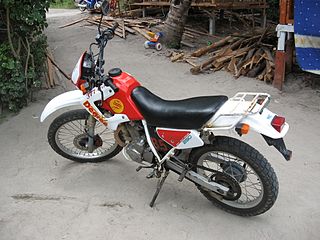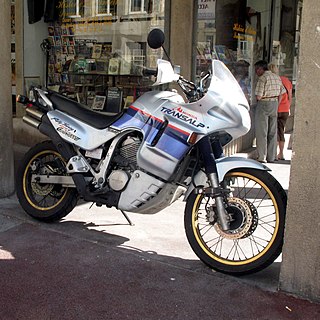Features
As a special feature was advertised that "... it does not need a fuel-oil mixture, but regular gasoline. This keeps the engines clean right up to the exhaust. Typical of the 4-stroke technology are the rich, round run and the low gas consumption. And what's going on, lasts long These mokicks have the great technology of Honda."
Especially for the German market with its then road traffic licensing order (StVZO), the engine with a speed limiter was provided, which together with populated spark plug, the preset ignition timing, the carburetor and the translation of everything delivered Standard allowed only a maximum speed of around 40 km/h. From the motorcycle area adopted detail solutions such as tubular frame, tank, seat, side cover and Helmbefestigungsmöglichkeit and the four-stroke engine with cylinder, overhead camshaft and right manual gearbox with wet clutch made her a miniature motorcycle , The designer's ""Naughty Dax"" as the CY 50 in the Honda advertisement was called had developed for this model various, also in the production adopted improvements, which in the products of the competition in addition to the above-described four-stroke technology at that time still missing. For example, the five-fold adjustable rear struts to adjust the spring preload to the payload, a trip meter in speedometer and a six-liter tank, which allowed a range of about 200 kilometers.
Rear and front luggage carriers themselves allowed a versatile labor input, for example, in the transport of various hobby equipments. Unscrewable front and rear wheel rims allow comprehensive care, immediate hose repair and a light coat change in trouble-free self-assembly.
Vulnerabilities
A weak point of the model are the factory-rigid mounting tubes of the front and rear turn signals, which is why it already comes in light falls to significant damage, especially on the front indicators and their suspension (see picture).
The valve seats with valve rings manufactured at that time and the installed valves require that the engine be lead predominantly or at least occasionally with tetraethyl lead which is no longer available at service stations normal and premium gasoline is driven. [1] A declaration by the manufacturer authorized statement that prolonged operation without lead added in the fuel will definitely damage the engine concerned sooner or later is not known. However, from a list posted by Honda on the Internet, it can be seen that the CY50 can also be run on regular unleaded gasoline.
The design-related performance of generator (flywheel generator) with six-volt electrics was not designed to ensure that this Mokick is always driven with switched on lighting in the Federal Republic of Germany, as required by later amendments to StVO. Therefore, with this alternator under this driving mode, especially in the case of predominantly short-distance traffic, the optimum charging of the standard accumulators (on-board battery 6 V, 4 Ah) while driving no longer guaranteed, which may lead after some time with each 21-watt bulbs (6 V) operated turn signals lose their function.
The standard delivery tank cover, which was standard at least in Germany, could not be locked. In addition, heard as a signal generator in this country only a bicycle bell to the basic equipment.

The Honda CB750 is an air-cooled, transverse, in-line four-cylinder engine motorcycle made by Honda over several generations for year models 1969–2003 as well as 2007 with an upright or standard riding posture. It is often called the original Universal Japanese Motorcycle (UJM).
The Honda XR series is a range of four-stroke off-road motorcycles that were designed in Japan but assembled all over the world.

The Honda Shadow refers to a family of cruiser-type motorcycles made by Honda since 1983. The Shadow line features motorcycles with a liquid-cooled 45 or 52-degree V-twin engine ranging from 125 to 1,100 cc engine displacement. The 250 cc Honda Rebel is associated with the Shadow line in certain markets.

The Honda Gold Wing is a series of touring motorcycles manufactured by Honda. Gold Wings feature shaft drive, and a flat engine. Introduced at the Cologne Motorcycle Show in October 1974, the Gold Wing went on to become a popular model in North America, Western Europe and Australia, as well as Japan.

The Honda CX series motorcycles, including the GL500 and GL650 Silver Wing variants, were developed and released by Honda in the late 1970s, with production ending in most markets by the mid 1980s. The design included innovative features and technologies that were uncommon or unused at the time such as liquid cooling, electric-only starting, low-maintenance shaft drive, modular wheels, and dual CV-type carburetors that were tuned for reduced emissions. The electronic ignition system was separate from the rest of the electrical system, but the motorcycle could only be started via the start button.

The Honda VFR800 (Interceptor) is a sport touring motorcycle made by Honda since 1998. The model was the successor to the VFR750F and shares the V4 engine configuration with the Honda VF and VFR series.

The CB700SC Nighthawk 700S is a carburated, air-cooled, in-line four-cylinder motorcycle marketed by Honda solely in the United States for model years 1984–1986, with a standard or neutral, upright riding position, 6-speed transmission, hydraulic valve lifters, shaft drive, front bikini mini-fairing, gear indicator and 16" front wheel. At its introduction, the motorcycle carried a list price of $3,398.
The Killinger and Freund Motorcycle was an attempt in 1935 by a group of five German engineers from Munich to design a more streamlined and modified version of the German Megola front-wheel drive motorcycle. The work took three years to complete but the result was impressive. The engine displacement stayed the same as the Megola at 600 cc but was much lighter and more simplified than a standard 100 cc motorcycle of the time.

The Honda NR was a V-four motorcycle series started by Honda in 1979 with the 500cc NR500 Grand Prix racer that used oval pistons. This was followed during the 1980s by a 750cc endurance racer version known as the NR750. The oval piston concept allowed for eight valves per cylinder which generated more power due to the increased air/fuel mixture throughput and compression. In 1992 Honda produced around 300 street versions of a 750cc model, the NR, with a 90-degree V angle. Whereas the NR500 had used an oval piston with straight sides, the road going NR750 used an elliptical piston with curved long sides. The bike became the most expensive production bike at the time when it was selling for $50,000 and with the rarity, nowadays they rarely change hands.

The Honda CG125 or Honda CG is a commuter motorcycle made by Honda of Japan. It was in production from 1976 to 2008 in Japan and has been in production since 1992 in Pakistan. The CG was originally manufactured in Japan, but source for European market was eventually moved to Brazil in 1985, and to Pakistan in 1992 and to Turkey for the W and M models. The CG125 is powered by a 124 cc (7.6 cu in) four-stroke, overhead valve, single-cylinder engine that has changed little over the years.

The Honda CD175 is a 174 cc (10.6 cu in) motorcycle made from 1967 to 1979 by the Honda Motor Company. Described by Honda as a "great new all-rounder, at home around town or putting the highway behind you", it was the touring model in Honda's 175 cc motorcycle lineup that also included the sportier CB175 and the off-road CL175 version. The CD175 shared some components and design elements in common with other models from Honda including the early-model pressed steel backbone frame, sometimes known as "T bone".

The Harley-Davidson Sportster is a line of motorcycles produced continuously since 1957 by Harley-Davidson. Sportster models are designated in Harley-Davidson's product code by beginning with "XL". In 1952, the predecessors to the Sportster, the Model K Sport and Sport Solo motorcycles, were introduced. These models K, KK, KH, and KHK of 1952 to 1956 had a sidevalve engine, whereas the later XL Sportster models use an overhead valve engine. The first Sportster in 1957 had many of the same details of the KH including the frame, fenders, large gas tank and front suspension.

The Honda CB175 is a standard motorcycle made by Honda from 1969 to 1973. It had a 174 cc (10.6 cu in) four-stroke, straight-twin engine with a single overhead camshaft, two valves per cylinder, dual slide-valve carburetors, and dual exhausts. It was also equipped with a five-speed gearbox, 12-volt electrics, kick and electric start, front and rear drum brakes, turn signals, speedometer with trip meter, and tachometer, and was rated at 20 bhp (15 kW). An update in 1972, brought a more rounded gas tank and changes to the air box covers, along with some other minor trim changes. The CB175 was discontinued for 1974 and replaced by the CB200, a similar bike already in production. Although not technologically remarkable, Honda's small twins of the 1960s and 1970s were among their best sellers. Dual sport scrambler CL175 and touring CD175/CA175 versions were also produced.

Honda XL250 is a four-stroke 250 cc (15 cu in) motorcycle from Honda introduced in 1972 and manufactured through most of the 1980s. When it appeared it was the first modern four-stroke enduro motorcycle and the first mass-produced four-valve motorcycle.
The Honda CT series was a group of Honda trail bike motorcycles made since 1964. The CT designation is a slight exception in Honda nomenclature in that "CT" does not indicate a series of mechanically related bikes, but rather a group of different bikes that are all for casual off-road use.

The Honda XL125V Varadero is a dual-sport motorcycle with a 125 cc four stroke V-twin engine, produced by Honda since 2001.

The Honda Transalp is the XL400V, XL600V, XL650V, and XL700V series of dual-sport motorcycles manufactured in Japan by Honda since 1987. The Transalp bikes series feature a liquid-cooled, four-stroke 52° V-twin engine.

The Honda XLV750R is a dual-sport motorcycle manufactured from 1983 to 1986 by Honda Motor Company, Japan. A first prototype of the motorcycle was introduced to the public at the Paris Motor Show in October 1982. The XLV was initially intended for the European market only, but from 1985 on, it was also sold in Australia and New Zealand. In the first production run in 1983, 500 "Limited Edition"-models were produced for the Japanese home market. The "Limited Edition"-models can be identified by a golden metal badge attached to the right side of the auxiliary frame and are otherwise, except for the perforated front brake disc and the blue strap on the seat, identical to the standard model.

The Honda PC50 is a moped produced by the Honda Motor Company in Japan from May 1969 until February 1977. The PC50, though much smaller and lighter, had some similar features to Honda's popular C50 /70 /90 Super Cub line, with a step-through pressed-steel frame, a fuel tank under the saddle, a chain cover, and optionally equipped with leg shields,

The Honda C92 Benly is a 125 cc (7.6 cu in) parallel-twin motorcycle made by Honda from 1959 through 1965. Running concurrently were the CB92 Sports and the slightly larger C95 150 cc (9.2 cu in), called the CA92 and CA95 in the US. These twins took their styling and design cues from the larger-displacement Honda C71, C76, C72, C77 Dream series.

















